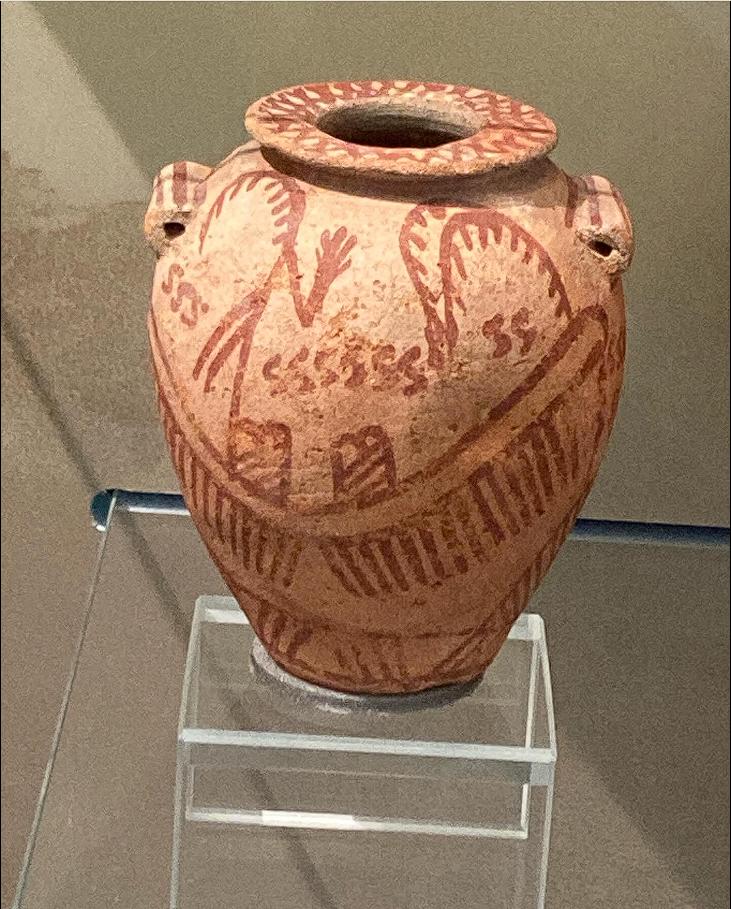“The discovery of a remarkably well-preserved jar at Naqada, a pivotal archaeological site from Predynastic Egypt, has provided a profound window into the symbolic world of a civilization on the cusp of monumental change. This 5,000-year-old vessel, adorned with intricate painted scenes centered on a boat and enigmatic S-shaped motifs, offers a glimpse into the early Egyptians’ complex beliefs about life, death, and the divine, long before the rise of pharaohs and hieroglyphs.”
A Vessel of Symbolic Significance: Unveiling Predynastic Beliefs
- The Naqada Discovery:
- The excavation at Naqada, a site crucial for understanding Predynastic Egypt, unearthed a jar of exceptional preservation and artistic detail. This discovery was not merely an artifact retrieval but a portal into the early Egyptians’ spiritual and cultural landscape.
- The jar’s context within the Naqada culture, a period marked by significant social and technological advancements, underscores its importance in understanding the nascent stages of Egyptian civilization.
- Boat Imagery and Funerary Rituals:
- The painted scene on the jar centers on a boat, a recurring motif in Naqada pottery, suggesting its profound symbolic significance. The presence of two fronded standard poles on the deck further reinforces its ritualistic or funerary connotations.
- Scholars propose that these boat images represent vessels used in funeral processions, symbolizing the deceased’s journey to the afterlife. This interpretation highlights the early Egyptians’ preoccupation with death and their belief in a continuation of life beyond the physical realm.
- S-Shaped Motifs and Cultural Connections:
- The jar features distinctive S-shaped motifs, repeated in clusters across the deck area. This symbol, recently linked to a tattoo found on a female mummy from Gebelein, suggests a broader cultural significance that transcended artistic mediums.
- The connection between the jar’s motifs and the Gebelein tattoo implies that these symbols held spiritual or protective meanings, permeating both artistic and bodily expressions in early Egyptian society.
A Visual Language: Expressing Beliefs Before Hieroglyphs
- Symbolic Representation:
- The boat imagery and S-shaped motifs on the Naqada jar demonstrate how early Egyptians used visual language to express complex beliefs and ideas. These symbols served as a form of communication, conveying spiritual and cultural messages before the development of hieroglyphic writing.
- This reliance on visual symbols highlights the early Egyptians’ sophisticated understanding of abstract concepts and their ability to translate these concepts into tangible forms.
- Life, Death, and the Divine:
- The jar’s imagery provides insights into the early Egyptians’ understanding of life, death, and the divine. The boat, symbolizing a journey to the afterlife, and the S-shaped motifs, representing spiritual or protective forces, reflect their preoccupation with the mysteries of existence.
- These symbols reveal a worldview that was deeply intertwined with spiritual beliefs and ritualistic practices, shaping the early Egyptians’ understanding of their place in the cosmos.
- Predynastic Foundations:
- The Naqada jar serves as a crucial artifact in understanding the foundations of Egyptian civilization. It predates the age of pyramids and hieroglyphs, offering a glimpse into the cultural and spiritual roots of a society that would later achieve monumental feats.
- This vessel highlights the continuity of cultural themes and beliefs that would persist throughout Egyptian history, demonstrating the enduring influence of Predynastic traditions.
A Legacy of Symbolism: Connecting to Ancient Beliefs
- Funerary Practices and Afterlife Beliefs:
- The jar’s association with funerary contexts underscores the importance of afterlife beliefs in early Egyptian society. The boat imagery suggests a belief in a journey beyond physical death, a concept that would become central to Egyptian religion.
- This artifact provides valuable insights into the evolution of funerary practices and the development of afterlife beliefs that would shape Egyptian civilization.
- Spiritual and Protective Motifs:
- The S-shaped motifs, linked to the Gebelein tattoo, highlight the early Egyptians’ use of symbols for spiritual and protective purposes. These motifs may have been used to ward off evil spirits or invoke divine protection.
- This use of symbols reflects a broader cultural practice of imbuing objects and bodies with spiritual significance, a practice that would continue throughout Egyptian history.
- A Window into Early Egyptian Art:
- The Naqada jar offers a window into the artistic traditions of Predynastic Egypt. Its painted scenes and symbolic motifs showcase the early Egyptians’ skill in creating visually compelling and culturally significant artifacts.
- This artifact contributes to our understanding of the development of Egyptian art, highlighting the evolution of artistic styles and techniques that would later reach their zenith in the pharaonic era.
Conclusion:
“The Naqada jar, a 5,000-year-old vessel of remarkable preservation, provides a profound glimpse into the symbolic world of Predynastic Egypt. Its boat imagery and enigmatic S-shaped motifs offer insights into the early Egyptians’ beliefs about life, death, and the divine, revealing a culture deeply intertwined with spiritual and ritualistic practices. This artifact, a testament to the early Egyptians’ artistic skill and cultural sophistication, serves as a vital link to the foundations of a civilization that would leave an enduring legacy on human history.”

CÁC TIN KHÁC
Mary Walton: The Forgotten Inventor Who Helped Clean Up America’s Cities
Tomb of Queen Nefertari in the Valley of the Queens, Egypt
Discover the Hypostyle Hall of the Temple of Hathor at Dendera
Venus de Losange: Unveiling the Mystery of a 20,000-Year-Old Paleolithic Icon